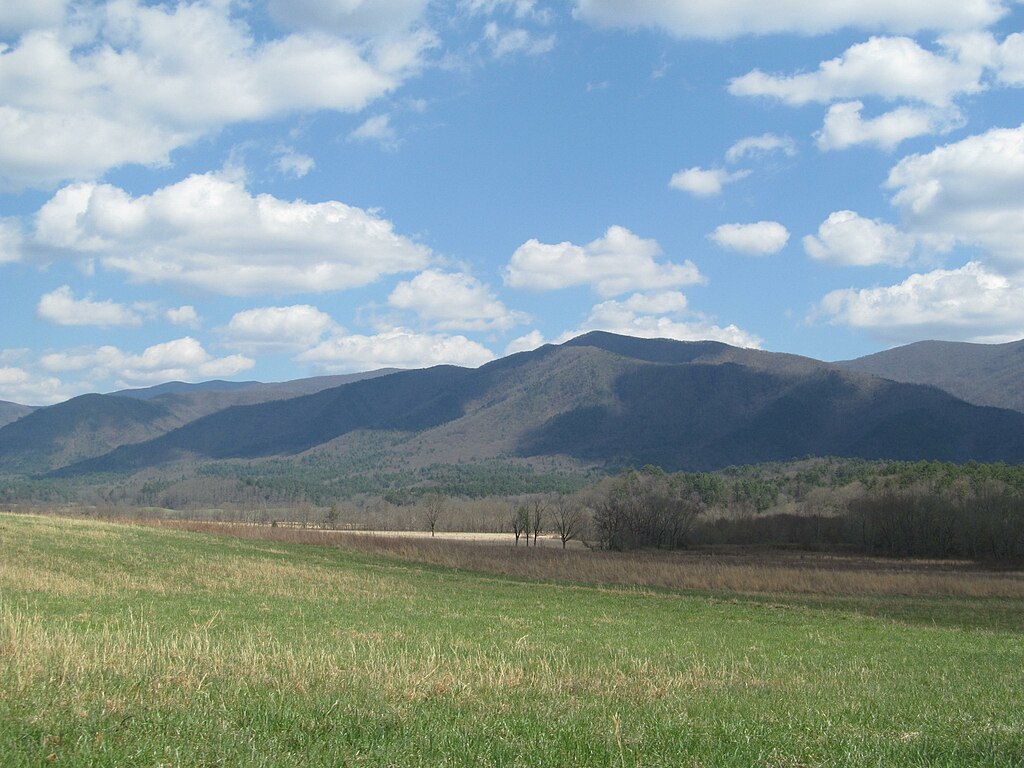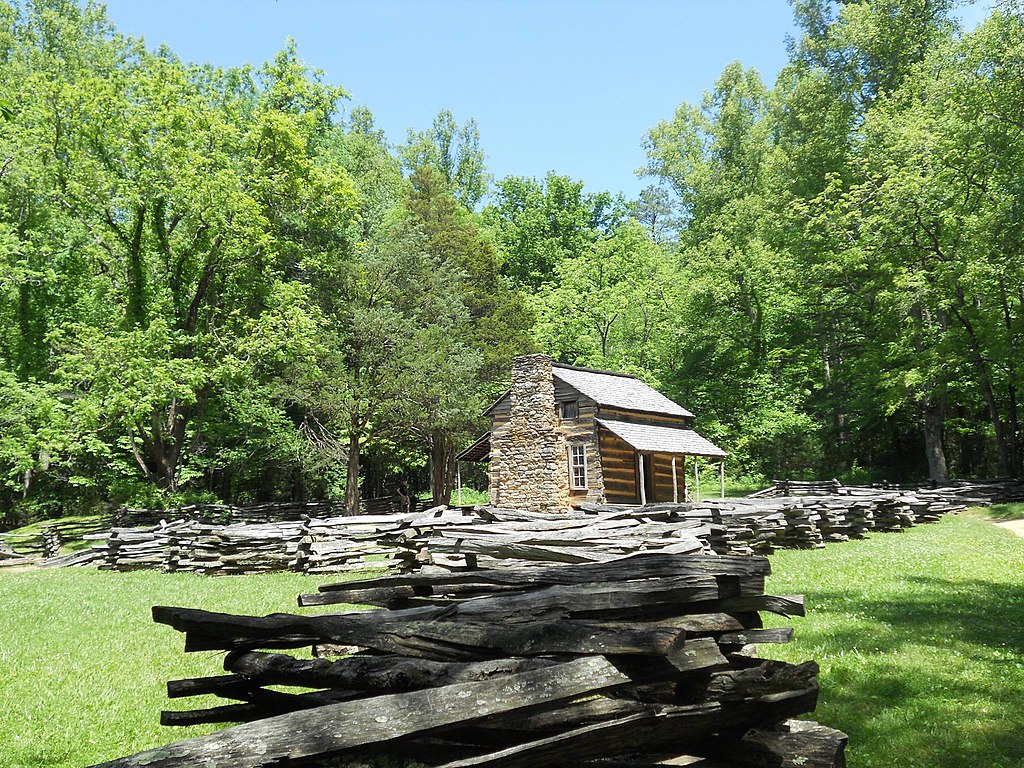On December 9, 1921, John W. Oliver, a farmer, mail carrier, and Primitive Baptist preacher in Cades Cove, Tennessee, had finished supper and was getting ready for bed when he looked out the window and discovered his barn was on fire.
There were five horses in there. Oliver swiftly rescued three of the horses from the blazing barn. Joe and Gib, the farm’s draft horses, were surrounded by flames in the center of the barn. Joe was too terrified to leave his stall. Thinking quickly, John removed his undershirt and covered Joe’s head, calming the horse enough so that he could guide him to safety. But despite his heroic efforts, Gib remained trapped and perished in the flames. Nearby neighbors saw the flames and ran to help. They formed a bucket brigade and worked furiously to save the nearby corn crib.
From Cades Cove: The Life and Death of a Southern Appalachian Community 1818-1937, by Durwood Dunn:
“In the meantime, many neighbors had come over and began trying to save the crib, which stood close to the barn. This crib contained a year’s harvest of corn and all the farm machinery. (11-year-old) Lucille and (14-year-old) Wayne carried dozens of tubs of water from the branch as the neighbors placed wet tow sacks on the crib roof, putting out the flames and wetting it down.”

As they were taking stock of what had been lost and what had been salvaged, word came that the barn belonging to John’s father, William Oliver, had also been set on fire and was a total loss, including the mules, feed, and farm tools inside it.
“The fire destroyed about twenty-five years of our hard labor,” William Howell Oliver later recalled, according to Dunn.
This was no coincidence; someone had it out for the Olivers. The foremost questions on John’s mind had to be “who” and “why.” The story goes that Oliver slept with a rifle in his third and only remaining barn for months after the fire in case the arsonists came for it.
On Sunday, New Year’s Day, 1922, Tom Sparks rode up and asked John Oliver to come to a meeting at Deputy Myers’ house. Gathered around a bonfire there, in the presence of Constable George Brown and two Justices of the Peace, Tom ordered his grandson, Wade Sparks, to tell the assembly what he knew about the burning of the Olivers’ barns. Wade Sparks confessed that Josiah “Joe Banty” Gregory and his wife, Elvira, paid him and their son, Dana Gregory $50 each to burn the barns. He subsequently testified to this in court.
Gregory got the nickname “Banty” because of his short stature and aggressive manner, like a bantam rooster. He was a moonshiner with a reputation for making high-quality corn whiskey. He and two of his sons had been convicted of making moonshine multiple times. The day before the fires, Gregory’s moonshine still had been raided by Deputy Sheriff John A. Myers and Constable Brown. He and his son, Earl, had been arrested. Someone had tipped off the sheriff, and Joe decided the Olivers were the prime candidates.
His reasoning appeared to be a combination of William and John Oliver’s long history of preaching against the evils of drink and that the officers had borrowed a team of mules and a wagon from William Oliver to haul away his large copper still and the confiscated whiskey. Later, it would turn out that a surveyor found the still and alerted the sheriff. Joe and Dana Gregory were already wanted men for the Christmas Day shooting of Asa and John Sparks.
A Disastrous Practical Joke
On Saturday night, Christmas Eve, Gregory’s son Earl and a friend, Perry Tipton, played a prank on John and Francis “France” Sparks. The two pranksters caught the Sparks boys walking home in the dark, jumped out, impersonated a couple of local lawmen, and pretended to arrest them. The victims knew something wasn’t right, but they didn’t recognize their friends. They beat the daylights out of the two imposters, and Earl got the worst of it.
When Joe Gregory found out about the prank and the subsequent beating the Sparks boys had handed out to his son, he decided to remove this stain on his family’s honor by swift and brutal retaliation. Joe Banty and Dana caught up with the Sparks boys the next day at the Sparks family Christmas celebration at the home of Fonze Cable. Joe Banty and Dana invited themselves in and were welcomed. What happened next was as unexpected as it was violent.
From Cades Cove: A Personal History by William Wayne Oliver (John Oliver’s son):
“After an hour or so, Joe remarked they should be getting home. At that, Dana picked up a wood fire poker and knocked John Sparks out of his chair and into the fireplace. Dana and Joe then pulled their revolvers and began shooting, wounding Asa and John Sparks. Calmly reloading their guns, they backed out of the house, mounted their horses, rode away, and disappeared from home.”
(Editor’s Note: Newspaper articles place the shooting at the home of John Marr. Dunn says the incident took place at the Dan Myers home.)
A Tuesday, December 27, Knoxville Journal and Tribune article reported that John and Asa were in Knoxville General Hospital. John suffered three intestinal wounds, and two perforations were found in his stomach. He was not expected to live. Asa, the paper identified him as A.C. Sparks, was shot in the back. He was expected to recover, but the next day, his condition worsened. Eventually, they both recovered. It’s not clear if the Gregorys mistook Asa for his cousin, France, or if he was just shot in the confusion. About a week later, Joe Banty and Dana Gregory were found hiding in the attic of a relative’s house and arrested.
From Cades Cove: A Personal History:
“A young boy named Henry Burchfield, who lived with Uncle Ike and Aunt (Kans) Tipton, appeared at Uncle Bud (James E.) Gregory’s store and bought a plug of apple chewing tobacco and a pair of cotton socks. Uncle Bud smelled a rat immediately. He knew Ike grew his own tobacco and never used any other kind, and that he wore wool socks the year around. Uncle Bud passed that information to Dave Sparks. That night officers and some of the Sparks men and a justice of the peace went to Uncle Ike’s house and found Joe Gregory and Dana holed up in the attic, arrested them and took them to the Maryville jail.”
Pardon My Crimes Governor
So what became of Joe Gregory and his family? How did they fare in court, and what were the consequences of the December rampage? The results were mixed, and the sentences turned out to be less than one would expect given the seriousness of the charges. Some claim that the wheels of justice were greased in the Gregorys’ favor. To paraphrase my uncle John, mill hand, warp doffer, and sometimes textile supervisor, “Who you know is more important than what you did.”
On July 5, 1922, Joe and Dana Gregory were found guilty of two counts of felonious assault and of assault with intent to commit murder in the second degree. They were sentenced to three to 21 years for the former and 15 years for the latter. They appealed to the Tennessee Supreme Court which affirmed their conviction on October 7, 1923.
On October 19, 1922, Dana was convicted for setting fire to John Oliver’s barn, and Joe and Elvira were found guilty as accessories. They were sentenced to from two to 21 years in the state penitentiary. A week later Judge Sam Brown, overturned the conviction because it was based wholly on Wade Sparks’ testimony, who was an admitted accomplice to the crime. A criminal conviction cannot be based solely on the uncorroborated testimony of an accomplice.
In that same October 1922 term of court, Joe and Earl Gregory were found guilty of two counts of manufacturing whisky. They were fined $250 for one count, $100 for the other, and sentenced to six months in the workhouse.
In his book, William Wayne Oliver tells us that John H. Mitchell, a Maryville druggist, and one of Joe Banty’s regular customers had some pull with Tennessee Governor Austin Peay. On December 24, 1923, the Gregorys made it onto Governor Peay Christmas pardon list. The notice in the Chattanooga News claims that more than 1,000 citizens signed petitions for the pardon. I can’t help but wonder if anyone counted the signatures. For attacking, shooting and nearly killing two men, they served two years.
In this story, it looks like justice came up a little short but it also appears that mercy and compassion ultimately triumphed. According to Dunn, when Joe Gregory died in 1933 at the age of 62, John Oliver was asked to conduct his funeral. Oliver agreed to perform this service and made every effort to console the grieving family. I cannot fathom the extent of this man’s compassion, forgiveness, and strength of character.

Transition to National Park
Tennessee and North Carolina began purchasing land for the Great Smoky Mountains National Park in 1927. Originally, Cades Cove was not planned to be part of the park. When plans changed to include his community, John W. Oliver fought a bitter six-year court battle that included three appeals before the Tennessee Supreme Court. In the end, the federal government, the state of Tennessee, and public disapproval proved to be more than he could overcome. On Christmas Day in 1937, he abandoned his 375-acre property.
The well-preserved homesteads and breathtaking mountain vistas of Cades Cove make it the most visited area of the park, drawing over two million visitors annually.
Check out my new book, Blood on the Blue Ridge: Historic Appalachian True Crime Stories 1808-2004, cowritten with my friend and veteran police officer, Scott Lunsford on Amazon. Buy it here! Download a free sample chapter here!
If you enjoyed this post, please consider sharing it with a friend. Click on one of the social sharing icons below. Do you have a hot tip on a cold case? Got a topic you’d like to see covered? Want to nominate a moonshine king, Appalachian outlaw, legendary lawman, massive manhunt, or blue-ribbon bloodhound for a future post? Clue me in with an email to editor@blueridgetruecrime.com.
Sources:
Dunn, D. (1988). Cades Cove the Life and Death of a Southern Appalachian Community, 1818-1937 (pp. 232–240)., University of Tennessee Press.
Oliver, W. W. (2014) Cades Cove: A Personal History (pp. 113-120), Great Smoky Mountain Association.
Cades Cove – Wikipedia. Cades Cove – Wikipedia, 2013. https://en.wikipedia.org/wiki/Cades_Cove
Knoxville Sentinel, 27 Dec 1921, Tue, Page 5 “Cade’s Cove Man May Not Survive Wounds”
Journal and Tribune, Knoxville, 08 Feb 1922, Wed, Page 5 “Gregories Held; Arson Charged”
Journal and Tribune, Knoxville, 06 Jul 1922, Thu, Page 5 “Liquor Sellers In Hard Lines”
Knoxville Sentinel 21 Oct 1922, Sat, Page 2 “Two Convicted Burning Barn in Blount County”
Journal and Tribune, Knoxville, Thursday, November 02, 1922, Page 5 “Busy Term of Court at Maryville”
Chattanooga News, 24 Dec 1923, Mon, Page 12 “Gov. Peay Grants Holiday Pardons”

